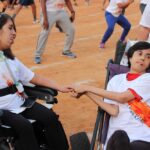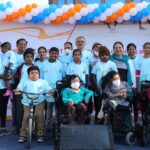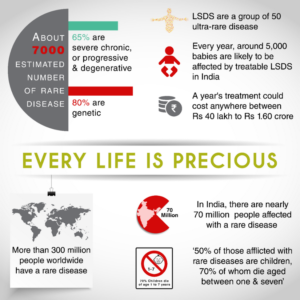

“A disease may be Rare but hope should not be” – Rare to the Rescue” . Yes 80% of rare diseases are genetic but there is lack of awareness and scarcity of medical professionals. Early diagnosis through prenatal screening is helpful.
A young women athlete of 24 years suddenly develops severe eye pain out of the blue. Investigations confirm a condition called Neuromyelitisoptica (NMO). This is an autoimmune disease that can cause inflammation and demyelination of the optic nerves and spinal cord. The clinical presentation of NMO can include blindness, paralysis, or worse. Less than 1 person out of 100,000 is known to be afflicted with NMO worldwide and this condition often strikes in the prime of life. This is what happens in adult onset “Rare Disease” which suddenly strikes and forever changes the quality of life of both the patient and the family members.
Living with a condition is never easy for the person or for the family, but what adds up to rare diseases are that even health care providers are often unaware of the clinical presentations as it’s a black box and not much is known about it. Thus, the title of “Rare” interferes with the clinical management protocols and in most cases these are treated on basis of symptoms without much understanding of the condition. By definition, Rare diseases describe those medical manifestations which affect a very small number of the population. There are three aspects to describe the condition based on the total number of persons having the disease, its prevalence and non-availability of treatment for the disorder. This definition was put forward to raise awareness about clinical manifestations that are neglected by health care professionals. The World Health Organization (WHO) has suggested that a rare disease should be defined as one with a frequency of less than 6·5–10 per 10,000 persons. Many countries define ‘rare’ or ‘orphan’ diseases as those affecting less than a specific number of persons in the populations. About 11 % of infants born every year have a genetic problem and about 3-4 % has congenital abnormality.
Rare Diseases are denoted by a broad spectrum of disorders and clinical presentations that are variable not only from disease to disease but also from patient to patient suffering from the same disease. 80% of rare diseases have identified genetic origins whilst others are the result of infections, allergies and environmental causes. Some are degenerative and proliferate while 50% of rare diseases affect children. In most of the cases, there are no existing effective cures adding to the high level of pain and suffering endured by patients and their families.
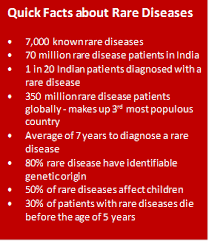

The WHO has stressed the need for prevention, early diagnosis and management of genetic disorders. The exact number of rare diseases is not known, but is estimated to be around 7000–8000 worldwide. With the rapid advances in genomic technologies in the last decade, the number is increasing steadily each year with new diseases and associated genes being discovered. About 80% of rare diseases are genetic in origin, many of which are thought to be monogenic (Global Genes. RARE Facts and Statistics).
Rare diseases include inherited cancers, autoimmune disorders, congenital malformations, and infectious diseases. Amongst others include Hemangiomas, Hirschsprung disease, Gaucher disease, Cystic Fibrosis, Muscular Dystrophies and Lysosomal Storage Disorders. The more common ones from out of 7,000 rare diseases are Down Syndrome, Muscular Dystrophy, Haemophilia, Thalassemia and Autism etc.
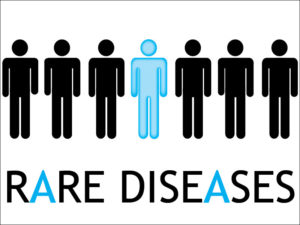

In developing countries, the time to diagnosis is even longer. Even after proper diagnosis, there is little hope for cure. Only around 400 FDA approved ‘orphan drugs’ are available on the US market, and ∼100 drugs approved by the European Medicines Agency (EMA) are available in the EU (Orphanet, 1997). Together, these approved drugs cover only about 11 million patients suffering from rare diseases leaving a majority of patients with no treatment options. Even where treatment is available, the cost is often prohibitive due to high development costs, fewer patients and lack of competition (Nogales, 2004). This is true for the enzymere placement therapies (ERT) that have been approved for mucopolysaccharidosis types I, II, IV-A and VI, Gaucher disease, Fabry disease and others. The prohibitive costs limit their use to very few patients in India and other low resource countries.
Charitable programs started for lysosomal storage disorders by companies and NGOs provide hope to some patients. These programs have also helped raise awareness among physicians, and stimulated them to make early and precise diagnosis. In India, enzyme therapies are provided either by the Pharma companies under their charitable programs, or by employers in India who are committed to giving ‘free’ health care to their employees and their dependents. A few associations of families of patients with rare disorders are also trying to persuade the government to cover the cost of therapies.
With the advance in technology genetic screening is at present not inaccessible through it is still extremely costly. Antenatal genetic screening helps the doctor in providing better health care services to the child or an affected adult. Prenatal screening of mothers or carrier screening in case of expectant parents helps to prevent child birth with gross anomalies or retardation. Genetic information about the condition would help doctors to confirm the diagnosis and also counsel and support families. Though genetic screening or diagnostic tests are at a hands distance, the choice of test, genetic counseling, and report interpretation are skills which need attention. There are very few genetic counselors to interact with the number of genetic reports generated. There is no guideline for screening and testing in case of most diseases. Also there are no protocol or rules that need to be followed at present in India to be able to judge the quality and judge the utility of such tests recommended by the clinicians. Most clinicians are not trained to understand or interpret such genetic report. The problem with insurance not covering the costs of a genetic screening or diagnostics test is a point of debate and policy makers would need to pay more attention towards having some kind of national guidelines for it.
Management of the diseases can also come in terms of prenatal screening and also detection or diagnosis in the fetus which would help families take an informed decision regarding the future of their pregnancy. Also this helps to plan properly in case an affected child is already present in the family. Advancement in technologies, have ensured that many chromosomal abnormality be detected as early as in 13 weeks of gestations and / also in an 8 celled blastcyst / embryo which helps parents to decide or even hope to have a healthy child.
Ref : Adapted from Organization for rare diseases India (ORDI) – addressing the challenges and opportunities for the Indian rare diseases’ community, Genet. Res., Camb. (2014), vol. 96, e009.
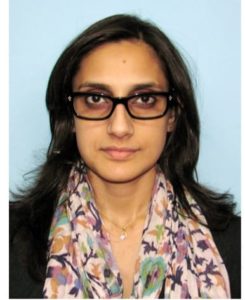

Dr. Dipanjana Datta
Molecular Geneticist, PhD, PDF (USA)
Senior scientist, Genetic Counselor
ORDI,
Bengaluru – 560055
Ph : +91 9980133300



